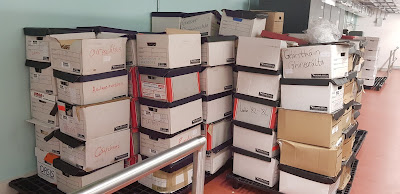In 2017, Conradh na Gaeilge announced
they would be donating their archive to NUI Galway where it is to be safely
stored and made accessible to researchers and interested parties in the James
Hardiman Library Archives. This summer it was subsequently announced that the material
had been transferred, and the identity of the archivist engaged to process the
collection was revealed. That lucky archivist is me, and over the next 18
months, alongside working through the collection, I will be writing a series of
blogs sharing my experiences and explaining the process involved, which I hope
you will find of interest. (As a word of caution, this introductory blog is a
bumper edition so probably a good idea to make a cup of tea first!)
So let me introduce myself! My
name is Niamh Ní Charra, and I’m from Kerry, born to a Limerick mother and
Galway father, who incidentally met here while studying Science. (Without NUIG
I wouldn’t exist!) I graduated with an Electronic Engineering degree and worked
in America briefly before leaving that world to become a professional musician,
as you do! Following years “on the road”, I returned home to take a masters in Archives and Records Management. I
mention this varied background because of its particular use and relevance to the
work ahead which includes first-hand experience of the Oireachtas, Pan Celtic Festivals and other events mentioned in
this collection. Having a grá for
Irish is also a must!
 |
| The first pile of boxes which has completely taken over the processing room |
for a little longer until I am further down the road!
 |
| From another angle - approximately 280 boxes sit on 8 palettes |
 |
| The 2nd pile of boxes, with the final pile visible in the background |
KNOW WHAT YOU HAVE
At the core of processing a
collection is the act of getting control over it, both intellectually and
physically. While initially announced as 500 boxes, I estimate the final number
of banker boxes to be closer to 650. Each one has to be opened and its contents
examined before I know what is in the collection. This is the first pass and
due to the size of the collection I have decided to combine a few stages while
conducting it.
 |
| An example of what awaits when lifting the lid on a box! |
MAKE IT SAFE
While examining the contents of
each box, I am also checking their condition for problems such as mould that
might spread. Contents are then removed from the current boxes and placed in
specially designed archive boxes and folders that help preserve them. These
boxes are then placed in secure storage in climate controlled storerooms. The
material is now both secure from further deterioration, and from theft. It is
also protected from environmental hazards such as fire and flood. During this
process, I list the contents of each box (known as a box-list), note what
format the items are in (paper, photograph, CD etc.), and make note of special
items of interest which may be candidates for digitisation. This box-list not
only summarises what is in the collection, it will also aid in deciding on an
arrangement for the collection once the first pass is complete.
 |
| Empty shelves in the climate-controlled storeroom where the archive boxes will be stacked once processed |
Not everything in a collection
should necessarily be kept – it may not be relevant or unique to that
collection. There can also often be duplication of material and in some cases
it may not be possible to suitably store an item due to its format, size or
other practical considerations. For that reason the collection needs to be
appraised. Appraisal is an important function of archivists and what separates
them from colleagues in other related professions. It is something I will go
into in more detail in future blogs, but for now, it is sufficient to note that
as I make this first pass, I am also appraising.
HOW LONG IS A PIECE
OF STRING?
One of the hardest tasks when
undertaking the processing of a collection is accurately estimating both the
time and the resources required. The above-mentioned stages are time-consuming
but essential before the collection can be made available to researchers and
until complete it is impossible to know definitively what is in the collection,
and therefore how long the subsequent stages will take. It is also impossible
to ascertain how long the initial pass will take, but we estimate it will
require 6 - 8 months to complete.
And there you have it! As you can
see, I have my work cut out for me! It is a pleasure and privilege to work on
this collection and I am enjoying coming across some real gems as I make the
first pass. Future blogs will cover these initial and subsequent stages in more
detail and the discoveries I make along the way as well as introducing you all
to Conradh, the organisation behind
this wonderful rich collection.
Go dtí an chéad uair eile,
Beir bua,
Niamh

No comments:
Post a Comment